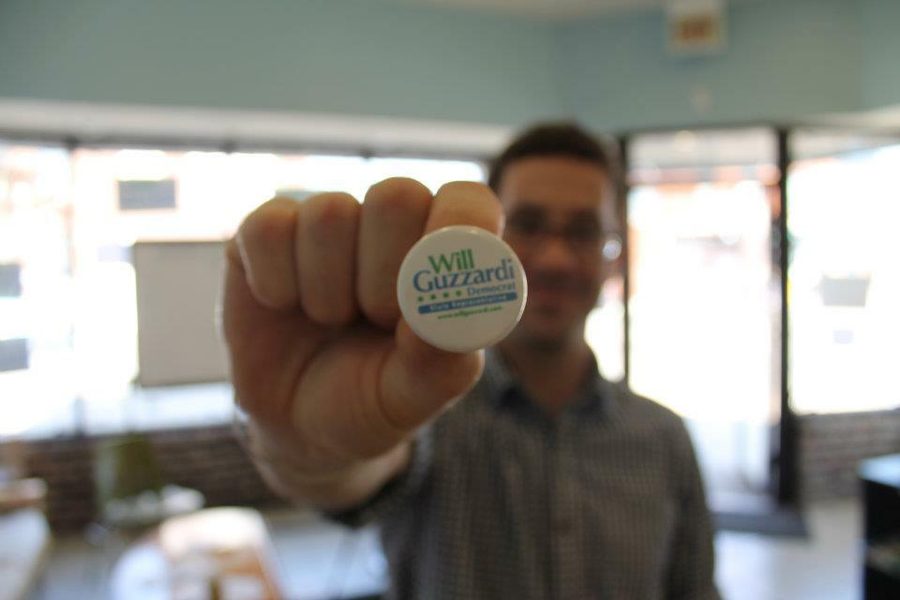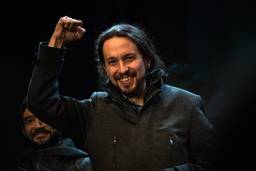
Will Guzzardi’s campaign manager tells the real story of how she took on Chicago’s powerful political Machine—and what lessons future progressives can use to change Illinois politics.
On an unexpectedly warm Tuesday night in March, several hundred people packed into the Logan Square Auditorium to celebrate a huge victory for Chicago progressives—and an all but unprecedented defeat for the city’s powerful political Machine.
Many were exhausted, having woken up before dawn to volunteer. But the mood was pure joy, as people cheered, pumped their fists, and hugged whoever happened to be standing next to them. Scattered throughout the crowd were volunteer leaders wearing bright blue shirts proudly proclaiming them to be members of “Team Guzz.”
This was the election night victory party for Will Guzzardi, a 26-year-old former journalist who took on six-term incumbent Rep. Toni Berrios, the daughter of powerful Cook County Democratic Party chairman Joe Berrios. After having come just 125 votes shy of winning two years ago, Guzzardi had just won decisively with 60% of the vote in the Democratic primary for 39th District state representative. Later that week, MSNBC’s Chuck Todd named Will one of Illinois’ “rising political stars” who was among those most likely to become a national name.
A lot has been said about our campaign and why we won. A lot of it missed the mark. As Guzzardi’s campaign manager, I want to share the real lessons from inside our campaign, about what we learned and how Chicago and Illinois progressives can continue building momentum heading into upcoming elections.
1) We used grassroots organizing to get our message out
A big part of how we won was by having Will and volunteers out talking to voters as much as possible, making the case for why they should support Guzzardi and not our opponent.
We started organizing in September, four months earlier than Rep. Berrios. We held huge canvasses almost every Saturday, with 30-40 people showing up despite several Polar Vortexes and the coldest winter in Chicago history.
Will knocked on more voters’ doors than anyone—five hours each weekday, eight hours every weekend day, listening to their concerns, explaining why he was running, and asking for their support. He set the example, and time and again I heard our amazing volunteers say, “I know Will’s out there knocking on doors right now, so I guess I don’t have any excuse.”
We also invested in our people. When big campaign donations started coming in towards the end, we didn’t just do more TV and mail—we hired a “street team” made up of some of our top volunteers to talk to even more voters, plus extra data-entry volunteers to keep up with the piles of walk sheets that just didn’t stop coming. Despite claims to the contrary, running our own in-house field program meant that we had dedicated, motivated volunteers with thorough training and the ability to talk to voters about why this race mattered to them.
In contrast, the Berrios campaign seemed to hardly be out talking to voters. They spent money on piles of negative mail (more than 40 pieces altogether) and negative TV ads attacking Will. The people out knocking on doors for Berrios were paid canvassers who often didn’t seem very invested in the outcome of the race.
But all that voter contact doesn’t matter if the message you’re delivering at the doors isn’t resonating with voters.
Because Will was our most active canvasser, and had been knocking on doors since 2011 when he ran for the first time, he had a good idea of what people’s concerns were and what messages were resonating with them. We used that, combined with message testing in polling early on, to develop scripts for our volunteers and the overall message for the campaign.
2) Guzzardi won the Latino neighborhoods—and debunked the “hipsters vs. Hispanics” story
The media was fixated on the story that our race pitted Will’s “hipster” supporters—the newer, younger, white residents moving into gentrifying Logan Square—against the traditional Hispanic population of the district, who would support the Latina candidate and vote for Toni Berrios.
But does anyone really think there’s a “hipster” voting bloc?
In a low-turnout primary election, it’s the people who are most invested and engaged in the community who are going to vote, and that’s who we focused on. In addition to talking to older voters, that meant reaching out to Latinos across the district.
Will was interviewed and featured on the cover of Spanish-language daily Hoy—once before the election and once right after. He appeared on Spanish radio and a segment on Telemundo—one Toni Berrios was scheduled for but didn’t bother showing up at.
We also did a pretty awesome TV ad in Spanish, made by the great team at HardPin Media:
While the Machine banked on the idea that Latino voters would support a Latino candidate, Will got out and worked to earn every last vote, regardless of voters’ race, or ethnicity. Our campaign built a diverse coalition of supporters from all types of backgrounds and parts of the district. We showed that there is a huge desire for new leadership, and that voters are ready to support a new and independent candidate when they’re given the option.
On Election Day, Will won four out of five Latino-majority wards in our district, and came close (46% of the vote) in the only ward he lost—the 31st Ward, where the Berrios family lives and Joe Berrios is the local party committeeman.
3) Voters supported Will because he was an independent outsider candidate—not in spite of it
As the Berrios campaign liked to point out, Will doesn’t come from Chicago. He’s a 26-year-old with more experience in journalism, tutoring chess, and improv than holding political office (of which he’s had none). He’s a progressive activist who’s organized against school closings, fought for an elected school board in Chicago, and helped pass online voter registration in Illinois.
To the political establishment, being an outsider is a liability. But to lots of voters, it’s a good thing. They feel like those in power aren’t working for them, and they want someone who isn’t part of that same broken system.
It’s important for actual progressive outsiders to run for office. If you limit candidates to those who have connections, or can raise a lot of money, you’ll just be replacing one insider with another. We need real progressive candidates who will stand up for their communities—even if that means going against other powerful interests or politicians. Being a good candidate and running a smart campaign aren’t the easiest things, but it’s more important to have people who are running for the right reasons. They can learn the rest.
4) The attacks didn’t work
We knew from the beginning that the Berrios campaign would try to bury us in an avalanche of negative mail, but their attacks just didn’t work.
Our opponent’s campaign tried out a handful attacks early on, but once they settled on one in February, they went for it hard. They seized upon an article Will wrote in college in which he referred to sex offender registries—in the context of criticizing private, for-profit companies for selling access to ex-offender criminal records— as “double jeopardy.”
The Berrios campaign line was that Will had a secret plot to weaken Illinois sex offender registries and allow dangerous sex predators and convicted rapists to run wild and attack your children. Really.
Berrios hammered Will in daily mail pieces showing little blonde girls getting lured into cars, scary men’s faces lurking in the shadows, and one particularly disturbing piece with a young girl with large, dirt-stained hands ominously placed on her shoulders from behind. Berrios staff handed out similar flyers at community forums, and even had high-school volunteers, sent to her campaign to learn about civic engagement, hand out these “community alerts” telling people the number of sex offenders in their neighborhood.
These attacks were truly despicable. This is why so many people don’t want anything to do with politics.
While our hardcore supporters dismissed the attacks as ridiculous, some swing voters were concerned. We got worried phone calls at the office, from women voters in particular, saying, “Will seemed like such a nice young man when he stopped by my door, but is what they’re saying about him really true?”
We responded to the attacks in a number of ways—from flyers with the facts that volunteers gave to voters at doors, to a mail piece from local aldermen. But more important than responding to the attacks was the fact that Will had met and earned the support of many voters before the attacks even began.
Not even the Chicago Machine could afford to blanket the district with glossy mailers for a full six months, and by the time the worst of the attacks began, we had already identified nearly all of the Guzzardi supporters we knew we needed to win.
We kept in touch by sending them postcards for Thanksgiving, New Year’s, and Valentine’s Day, which thanked them for supporting Will and reminded them of their commitment to vote for him on Election Day. There was something great—and telling about each campaign’s approach—about the juxtaposition of our supporters getting these terrible attack mailers from Berrios, while at the same time getting a friendly, heartfelt holiday card from our campaign.
In the end, the Berrios effort to peel away Guzzardi support through the attacks wasn’t effective. Nor does it appear that the attacks depressed turnout, as traditional political wisdom may suggest (the idea being that when campaigns go so negative, voters get disgusted and stay home, benefitting the incumbent.)
Helped in part by our massive Get Out the Vote program, turnout increased by 11% over 2012—including a 43% increase in the number of people who voted early—and was several points higher than the 2014 citywide average.
5) We embraced the latest innovations in campaign research and technology
In the past few years, political campaigns have made huge strides to become smarter and more data-driven—and Chicago has been at the center of much of it. In 2008, Barack Obama’s campaign pioneered online tools that helped supporters around the country organize to help grow the campaign in their communities. That, combined with using email and new technology to fundraise and build support, took Howard Dean’s 2004 efforts and brought them to the next level. In 2012, Obama built on this, adding a secret team of data analysts in “the cave” at the Chicago headquarters, running experiments across the country.
Unfortunately, most of these campaign innovations haven’t reached the level of local races, in Chicago or elsewhere. We may not have had our own “cave” on the Guzzardi campaign, but we took the research and cutting-edge technology from the Obama world and other large campaigns and applied them to our race.
We tapped into a network of folks I had worked with on the Obama 2012 digital team, people with skills in data analysis, graphic design, email, photography, and video.
By engaging this group, we were able to run a small but effective digital program with some of the best minds in online politics (many now at Organizing for Action, 270 Strategies, and Civis Analytics) that helped recruit volunteers and kept our supporters engaged over the course of the campaign.
We also adopted many voter outreach best practices from the Analyst Institute, a research consortium that runs experiments and centralizes the latest research so that it can be put to use by progressive campaigns. We asked voters to sign a “Commit to Vote” postcard when we spoke to them at their doors, which we then mailed back to them one week before the election, reminding them of the promise they had made to themselves and to Will. Leading up to Election Day our volunteers had conversations with supporters that walked them through their plan for where, when, how, and with whom they would vote—Analyst Institute experiments have shown that when people visualize voting, they are more likely to do it.
But while technology can help make campaigns more effective, it’s important not to get distracted by the flashiness of data and digital (the media exemplifies this distraction with its obsession over the data geeks of “the cave”).
Talking to voters is first and foremost the most important part of a local campaign, and data and technology have to be used to support those efforts. After all, the latest research shows that the most effective thing a campaign can do is the most low-tech: in-person conversations that voters have at their doors with trained volunteers who care about the campaign.
6) It’s not just the political Machine that’s broken—it’s our voting system
We prepared for Election Day by training an army of volunteer poll watchers (about 80 in all), but there were still serious voter protection issues at the polls.
One polling place opened more than two hours late because the building managers were nowhere to be found and no one could open the front door. A number of people were given ballots for the wrong districts, which meant Will wasn’t even listed as a choice. Our polling place observers were yelled at—and at times kicked out of polling places altogether—by election judges. Many election judges, some of whom were high-school students who themselves had never voted before, had no idea how to operate the new machinery.
Whether these episodes were deliberate or not is beside the point. What’s easy to dismiss as one-off instances of foul play or simple incompetence is actually a completely broken system. That’s why we need to push for things like same-day voter registration, an Election Day holiday, and universal voter registration. The awesome folks at Chicago Votes are working on this—you can sign their petition for same-day voter registration here: ChicagoVotes.org/SameDay.
7) The Machine isn’t that organized—or even that popular
Will’s race challenged the assumption that Chicago Machine has a lock on local politics. For years, voters hadn’t had a choice of candidates.
A good number of them simply didn’t like Berrios. They felt she hadn’t been there for the community, and many had never met her during her 12 years in office.
They had met Will at their doors, often more than once, and they appreciated that he had taken the time to listen to them. A lot of them became volunteers after Will knocked on their door.
Chicago is notorious for elections in which incumbents run unopposed. It’s important for new candidates to challenge incumbents—whether or not they win, primary challengers make elected officials actually work for their positions, which then makes them better and more accountable to their communities.
In summary, here’s my advice for candidates and progressives who want to do what Will Guzzardi did. Spend most of your time knocking on voters’ doors and making fundraising calls, delivering a clear message about why you’re running. Be realistic about your resources, but also a little insane to think you can do what you’re trying to do. Invest in people, paying organizers and data staff. Stay committed to your values and know you can be an outsider and still succeed. If you don’t win the first time, run again. Be prepared for everyone to tell you that you can’t win. Don’t listen to them.
We’re building huge progressive momentum here in Chicago and Illinois. More outsider candidates like Will can challenge the Machine and win—if they run people-powered, data-driven grassroots campaigns.
This was a big victory, but with critical races coming up this year and beyond, we’re just getting started.
Reprinted with permission from the Illinois Observer.
Erica Sagrans is a writer, activist and a member of In These Times’ Board of Directors. She perviously worked as the campaign manager of Ready for Warren, a grassroots effort to draft Elizabeth Warren to run for president in 2016. You can follow Erica on Twitter at @EricaS.




